
Every March, the Academy of Nutrition and Dietetics serves up its month-long campaign dedicated toward nutrition education. We want to make the topic a main course here as well, and one you can digest all year round.
With our first entree, we followed the US Department of Agriculture’s (USDA) MyPlate guidelines and split our plate into four quarters, with each representing a specific food group – proteins, vegetables, fruits and grains. We then identified several significant health benefits offered by proteins and recommended some of the better kinds that are worth sampling. (You can read that article by clicking here.)
For our next course, we’re covering fruits and vegetables. There isn’t really too much that separates the two groups aside from their botanical differences – fruits are the plant portion that develop from a seed-containing flower, while vegetables stem (pun intended) from other edible portions of the plant. Some people believe that vegetables are healthier because fruits contain more natural sugar and are therefore more calorie-dense. Others contend that fruits are more diet-friendly and offer healthier caloric content.
Based on their nutrients and health benefits, we think that so long as they cover half of your plate, there’s no reason why vegetables and fruits can’t just get along. Studies show that the vitamins and antioxidants in produce can help reduce risks in certain cancers.[1] They can also control, if not lower, blood glucose and insulin levels,[2] and they significantly lessen the chances of cardiovascular disease[3] as well as eye and digestive issues. Oh, and lest we forget, a higher intake of both food groups can help thwart putting on those unwanted extra pounds, or even assist you in losing weight.[4]
Averaging between 3 and 3½ cups of vegetables, plus 2 cups of fruits, are the recommended daily amounts in a 2,500-calorie diet. What, however, are the healthiest types of vegetable and fruit to fill those cups? Just about all of them deliver nutritionally, so your cups can easily runneth over. So let’s a little informative fun and select some produce that’s best for you according to color.
For years, there has been measurable debate over whether the color of a certain fruit or vegetable makes it more nutritionally valuable than the color of another. There’s no argument, however, that color can be an indicator[5] of the antioxidant properties contained within them.
The colors in produce originate from phytochemicals, also known as phytonutrients (or heck, natural plant pigments), that reflect in visible-range light. As such, they help determine vegetables’ antioxidant activity.[6] Perhaps even more interesting, a variation in color between two of the same fruit or vegetable may result in a variance of antioxidants, mineral and vitamin values.
Regardless of color or taste, you’re encouraged to change up your produce regularly so a) you don’t grow weary of the same-looking (and tasting) plate day-in, day-out and b) you can receive a wider array of vitamins and nutrients. Let’s provide you with a color wheel of choices worth considering.
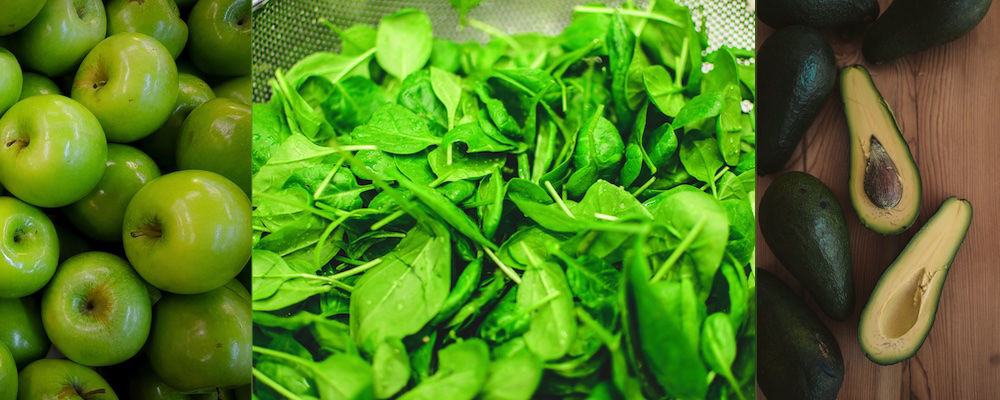
GREEN
Green is considered by many to be the gold standard of vegetables. Deriving their hue from the phytochemical chlorophyll, dark green, leafy veggies – including perennial favorites spinach, lettuce and kale – are packed with fiber, folate, potassium, testosterone boosters like boron[7] and magnesium,[8] calcium, iron, and Vitamins A and E. They also have an abundance of Vitamin K, which can effectively combat inflammatory disease and protect against osteoporosis.[9]
Both leafy and cruciferous green vegetables (by “cruciferous,” we mean broccoli, cauliflower, cabbage, collards, arugula and Brussels sprouts) also contain multiple carotenoids, which tend to be more associated with providing the colors for red, yellow and orange produce. Carotenoids, according to studies, can protect cells and act as preventative agents of early-stage cancer.[10] Cruciferous vegetables offer an additional advantage in that they’re rich with glucosinolates,[11] sulfur-containing compounds that are linked to lowering the risk of colorectal and lung cancer.
We haven’t forgotten about vegetables’ emerald peers. Fruits are stacked with many of the same vitamins, potassium, folate, fiber and phytonutrients. Some, like green apples, also contain pectin,[12] a fiber source that helps break down food and promotes the growth of healthy gut bacteria. If you’re looking for some healthy fat in your diet, one of your best bets is the avocado. They’re filled with monounsaturated fatty acids, or MUFA,[13] which research indicates can reduce the risks of cardiovascular disease.
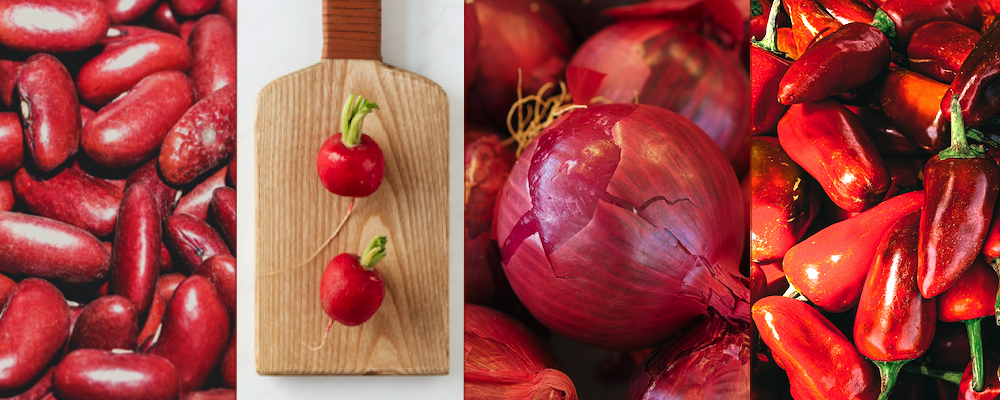
RED
The color red often signals a warning or high alert – basically, something to be concerned about. It’s the opposite with regards to vegetables and fruit. Naturally red produce, including kidney beans, cabbage, and bell and chili peppers, can literally be a sight for sore eyes,[14] seeing as they help protect against cataract development and age-related macular degeneration.
Besides being stacked with immune system supporters like Vitamins A and C as well as potassium and folate, these scarlet goods contain the phytonutrients lycopene and anthocyanin. Studies support that as the top carotenoid found in red produce, lycopene has heart-healthy properties that can decrease the risk of cardiovascular disorders.[15] It can also provide some sun protection for your skin[16] and, like we mentioned earlier about carotenoids, it’s effective in reducing the growth of cells[17] that can result in prostate, bone or lung cancer.
Anthocyanins, flavonoid antioxidants found in the likes of red onions,[18] beets and red grapes, offer benefits similar to lycopene. They’ve also known for possessing antibacterial, antidiabetic and anti-inflammatory effects,[19] and studies show that they can effectively combat neurodegenerative disorders,[20] including Parkinson’s and Alzheimer’s Disease.
If you’re looking for more Vitamin C in your life, we recommend red radishes and grapefruit. The compounds in radishes aid your liver and stomach in detoxifying and healing against damage,[21] plus they help your kidneys flush out toxins.[22] Grapefruit, meanwhile, is arguably the go-to fruit to aid you in weight loss.[23] They also contain the compound furanocoumarins,[24] which one study shows can promote bone health and protect against oxidative stress and tumors.
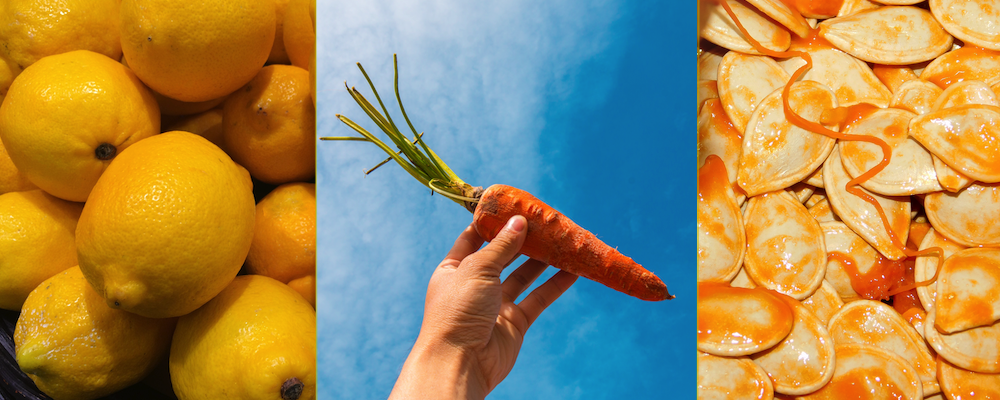
ORANGE / YELLOW
Produce that is naturally colored orange and yellow possess many of the same phytochemicals found in their scarlet brethren, including lycopene, flavonoids, Vitamin C and potassium. They also contain carotenoids like lutein and zeaxanthin (also found in dark green, leafy produce), as well as alpha-carotene and beta-carotene. If the two carotenes and “carotenoid” read a bit like “carrot,” then you have a good eye, since that’s the vegetable where they were first identified. In fact, the reason you may have that good eye is because research shows how all four carotenoids successfully promote eye health, including combatting night blindness and reducing the risk of age-related macular degeneration.[25]
Alpha- and beta-carotene convert into provitamin A, which is not only good for the eyes, but for also lowering blood pressure, decreasing the risks of certain cancers and heart disease, stimulating your immune system and regulating hormone metabolism.[26] Yellow beets, tomatoes, sweet and yellow-fleshed potatoes, and the always-delicious corn are rich with these nutrients as well as lutein and zeaxanthin. Some dieticians recommend making potatoes and corn part of your grain intake because they’re high in the carbohydrate starch. However, they’re high in resistant starch and fiber, both of which, according to researchers, contribute to bone and digestive health as well as contain anticancer and antidiabetic properties.[27]
If you’re looking for produce that offers testosterone support, there are numerous carotenoid-colored options. Citrus fruits like oranges and lemons contain Vitamin C, which is great for blood flow and, according to research, can keep your T levels up[28] by keeping your cortisol levels down. Bananas possess high levels of bromelain,[29] magnesium[30] and potassium,[31] all of which studies show can effectively maintain or boost testosterone levels. Some may think we’re out of our gourds for also recommending pumpkin, but their seeds are teeming with fiber and the mineral zinc. Not only can zinc only modulate normal T levels,[32] but it can also improve your sperm quality and fertility.[33]
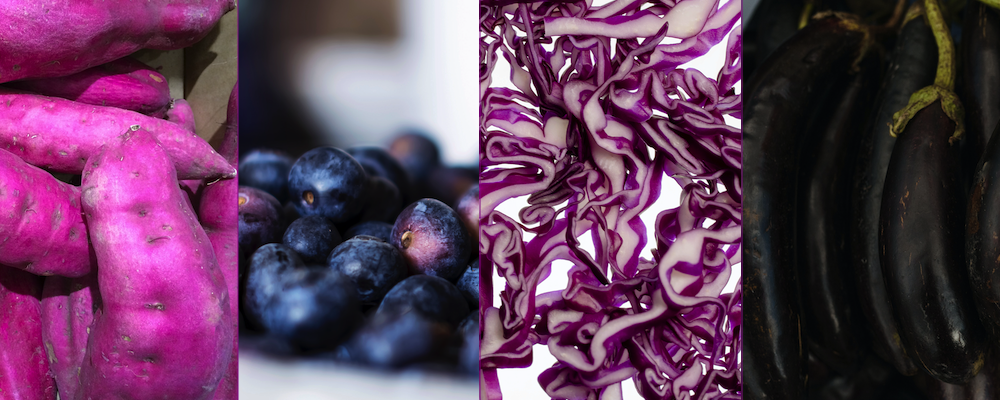
BLUE / PURPLE
Sugary snacks that are colored blue or purple? Sorry, we can’t recommend them. Vegetables that are naturally colored with those same hues? Sorry, we can’t recommend them enough. Like their reddish cousins, blue and purple produce get their vibrant or dark shades from anthocyanins. Furthermore, they contain an abundance of polyphenols that can help lower blood sugar levels[34] – a particularly vital benefit for those at risk of type 2 diabetes.
The colors may not sound quite so natural as others in the vegetable/fruit families, but we assure you, they’re normal. And according to researchers, the flavonoids can be quite beneficial for vascular function and cognitive behaviors. Blue and purple berries – including blueberries, blackberries, acai berries, elderberries, mulberries and even less “purple” ones like strawberries – are considered “brain food” because studies indicate they can inhibit damage caused by cerebral ischemia[35] and improve brain functions[36] such as memory, learning and problem-solving.
Blue and purple vegetables enjoy just as many fruitful health benefits. In addition to its ability to increase blood flow into the brain and lower blood pressure, eggplant possesses scopoletin, a phytonutrient that researchers point to helping decrease stress and depression.[37] If you prefer to load up on disease-battling antioxidants, purple sweet potatoes and cabbage are your violet-hued victors. The results of one study[38] determined that purple sweet potatoes offered significantly higher concentrations of anthocyanins and phenolic acids in comparison to white potatoes. Another study showed that purple cabbage provided antioxidant levels more than four times higher[39] than those within the green variety.
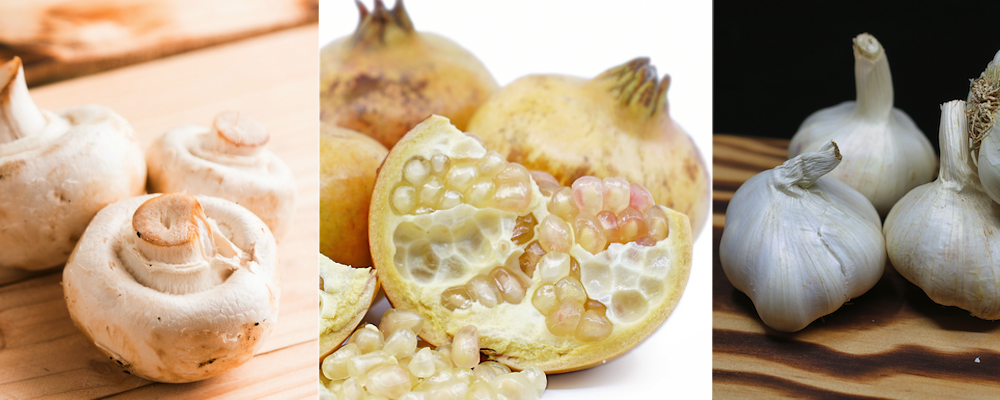
WHITE / COLORLESS
Deriving their pale color from the phytochemicals known as anthoxanthins, white fruits and vegetables may, on the surface, appear…lacking. Yet they’re vibrant with phytonutrients, minerals and vitamins,[40] and their health-promoting capabilities are bountiful. In fact, a population-based Dutch study[41] of more than 20,000 adults reported that throughout a 10-year period, only white produce was linked to a lower risk of stroke. Perhaps even more surprising, the risk of stroke incidence for adults with a high intake of white fruits and vegetables was 52 percent lower than adults with a low intake.
So, which white produce stands out from the rest of the colorless crowd? Garlic, despite its diminutive size, should near the top of any list. Even the ancient Greek physician Hippocrates[42] used to prescribe it. Often considered more as a flavoring, garlic is dense with calcium, copper, iron, manganese, phosphorous, potassium, selenium, thiamin, and Vitamins B and C. Plus, if you crush it, you get allicin, an oily phytonutrient with anti-inflammatory properties that can help combat degenerative joint disease, or osteoarthritis.[43]
Pomegranates may be considered in certain religious circles to be the true “forbidden fruit” in the Garden of Eden, but the white variety is a welcome addition on any plate. Rich in hydrolyzable tannins,[44] pomegranates’ antioxidant activity makes them another valuable ally against inflammatory arthritis. Mushrooms, meanwhile, are a pallid produce that sets the bar for delivering healthy benefits. Research cites that mushrooms are effective not only against inflammation and hypertension, but also at lowering cholesterol and protecting your liver.[45]
Naturally, there are seemingly countless other produce choices for you to enjoy and reap the health benefits from. We’ve provided but a mere morsel of colorful (or colorless) fruits and vegetables. The main thing is to make sure they cover at least half of your daily platefuls for a well-balanced, nutritional meal.
For more "Foods for thought," check out: Part 1: Proteins | Part 3: Grains
FOLLOW US ON FACEBOOK, INSTAGRAM, TWITTER AND YOUTUBE
References:
[1]Donaldson MS. Nutrition and cancer: a review of the evidence for an anti-cancer diet. Nutr J. 2004 Oct 20;3:19. doi: 10.1186/1475-2891-3-19. PMID: 15496224; PMCID: PMC526387.
[2]Wang PY, Fang JC, Gao ZH, Zhang C, Xie SY. Higher intake of fruits, vegetables or their fiber reduces the risk of type 2 diabetes: A meta-analysis. J Diabetes Investig. 2016 Jan;7(1):56-69. doi: 10.1111/jdi.12376. Epub 2015 Jun 22. PMID: 26816602; PMCID: PMC4718092.
[3]Tang GY, Meng X, Li Y, Zhao CN, Liu Q, Li HB. Effects of Vegetables on Cardiovascular Diseases and Related Mechanisms. Nutrients. 2017 Aug 10;9(8):857. doi: 10.3390/nu9080857. PMID: 28796173; PMCID: PMC5579650.
[4]Nour M, Lutze SA, Grech A, Allman-Farinelli M. The Relationship between Vegetable Intake and Weight Outcomes: A Systematic Review of Cohort Studies. Nutrients. 2018 Nov 2;10(11):1626. doi: 10.3390/nu10111626. PMID: 30400139; PMCID: PMC6266069.
[5]Cömert ED, Mogol BA, Gökmen V. Relationship between color and antioxidant capacity of fruits and vegetables. Curr Res Food Sci. 2019 Nov 21;2:1-10. doi: 10.1016/j.crfs.2019.11.001. PMID: 32914105; PMCID: PMC7473347.
[6]Liu RH. Health benefits of fruit and vegetables are from additive and synergistic combinations of phytochemicals. Am J Clin Nutr. 2003 Sep;78(3 Suppl):517S-520S. doi: 10.1093/ajcn/78.3.517S. PMID: 12936943.
[7]Pizzorno L. Nothing Boring About Boron. Integr Med (Encinitas). 2015 Aug;14(4):35-48. PMID: 26770156; PMCID: PMC4712861.
[8]Cinar V, Polat Y, Baltaci AK, Mogulkoc R. Effects of magnesium supplementation on testosterone levels of athletes and sedentary subjects at rest and after exhaustion. Biol Trace Elem Res. 2011 Apr;140(1):18-23. doi: 10.1007/s12011-010-8676-3. Epub 2010 Mar 30. PMID: 20352370.
[9]Pearson DA. Bone health and osteoporosis: the role of vitamin K and potential antagonism by anticoagulants. Nutr Clin Pract. 2007 Oct;22(5):517-44. doi: 10.1177/0115426507022005517. PMID: 17906277.
[10]Nishino H, Tokuda H, Murakoshi M, Satomi Y, Masuda M, Onozuka M, Yamaguchi S, Takayasu J, Tsuruta J, Okuda M, Khachik F, Narisawa T, Takasuka N, Yano M. Cancer prevention by natural carotenoids. Biofactors. 2000;13(1-4):89-94. doi: 10.1002/biof.5520130115. PMID: 11237205.
[11]Higdon JV, Delage B, Williams DE, Dashwood RH. Cruciferous vegetables and human cancer risk: epidemiologic evidence and mechanistic basis. Pharmacol Res. 2007 Mar;55(3):224-36. doi: 10.1016/j.phrs.2007.01.009. Epub 2007 Jan 25. PMID: 17317210; PMCID: PMC2737735.
[12]Jiang T, Gao X, Wu C, Tian F, Lei Q, Bi J, Xie B, Wang HY, Chen S, Wang X. Apple-Derived Pectin Modulates Gut Microbiota, Improves Gut Barrier Function, and Attenuates Metabolic Endotoxemia in Rats with Diet-Induced Obesity. Nutrients. 2016 Feb 29;8(3):126. doi: 10.3390/nu8030126. PMID: 26938554; PMCID: PMC4808856.
[13]Ford NA, Liu AG. The Forgotten Fruit: A Case for Consuming Avocado Within the Traditional Mediterranean Diet. Front Nutr. 2020 May 29;7:78. doi: 10.3389/fnut.2020.00078. PMID: 32548125; PMCID: PMC7272688.
[14]Schleicher M, Weikel K, Garber C, Taylor A. Diminishing risk for age-related macular degeneration with nutrition: a current view. Nutrients. 2013 Jul 2;5(7):2405-56. doi: 10.3390/nu5072405. PMID: 23820727; PMCID: PMC3738980.
[15]Mozos I, Stoian D, Caraba A, Malainer C, Horbańczuk JO, Atanasov AG. Lycopene and Vascular Health. Front Pharmacol. 2018 May 23;9:521. doi: 10.3389/fphar.2018.00521. PMID: 29875663; PMCID: PMC5974099.
[16]Cooperstone JL, Tober KL, Riedl KM, Teegarden MD, Cichon MJ, Francis DM, Schwartz SJ, Oberyszyn TM. Tomatoes protect against development of UV-induced keratinocyte carcinoma via metabolomic alterations. Sci Rep. 2017 Jul 11;7(1):5106. doi: 10.1038/s41598-017-05568-7. PMID: 28698610; PMCID: PMC5506060.
[17]Chen P, Zhang W, Wang X, Zhao K, Negi DS, Zhuo L, Qi M, Wang X, Zhang X. Lycopene and Risk of Prostate Cancer: A Systematic Review and Meta-Analysis. Medicine (Baltimore). 2015 Aug;94(33):e1260. doi: 10.1097/MD.0000000000001260. PMID: 26287411; PMCID: PMC4616444.
[18]Banihani SA. Testosterone in Males as Enhanced by Onion (Allium Cepa L.). Biomolecules. 2019 Feb 21;9(2):75. doi: 10.3390/biom9020075. PMID: 30795630; PMCID: PMC6406961.
[19]Khoo HE, Azlan A, Tang ST, Lim SM. Anthocyanidins and anthocyanins: colored pigments as food, pharmaceutical ingredients, and the potential health benefits. Food Nutr Res. 2017 Aug 13;61(1):1361779. doi: 10.1080/16546628.2017.1361779. PMID: 28970777; PMCID: PMC5613902.
[20]de Andrade Teles RB, Diniz TC, Costa Pinto TC, de Oliveira Júnior RG, Gama E Silva M, de Lavor ÉM, Fernandes AWC, de Oliveira AP, de Almeida Ribeiro FPR, da Silva AAM, Cavalcante TCF, Quintans Júnior LJ, da Silva Almeida JRG. Flavonoids as Therapeutic Agents in Alzheimer's and Parkinson's Diseases: A Systematic Review of Preclinical Evidences. Oxid Med Cell Longev. 2018 May 10;2018:7043213. doi: 10.1155/2018/7043213. PMID: 29861833; PMCID: PMC5971291.
[21]Manivannan A, Kim JH, Kim DS, Lee ES, Lee HE. Deciphering the Nutraceutical Potential of Raphanus sativus-A Comprehensive Overview. Nutrients. 2019 Feb 14;11(2):402. doi: 10.3390/nu11020402. PMID: 30769862; PMCID: PMC6412475.
[22]Kumar A. Influence of radish consumption on urinary calcium oxalate excretion. Nepal Med Coll J. 2004 Jun;6(1):41-4. PMID: 15449653.
[23]Fujioka K, Greenway F, Sheard J, Ying Y. The effects of grapefruit on weight and insulin resistance: relationship to the metabolic syndrome. J Med Food. 2006 Spring;9(1):49-54. doi: 10.1089/jmf.2006.9.49. PMID: 16579728.
[24]Hung WL, Suh JH, Wang Y. Chemistry and health effects of furanocoumarins in grapefruit. J Food Drug Anal. 2017 Jan;25(1):71-83. doi: 10.1016/j.jfda.2016.11.008. Epub 2016 Dec 6. PMID: 28911545.
[25]Wu J, Cho E, Willett WC, Sastry SM, Schaumberg DA. Intakes of Lutein, Zeaxanthin, and Other Carotenoids and Age-Related Macular Degeneration During 2 Decades of Prospective Follow-up. JAMA Ophthalmol. 2015 Dec;133(12):1415-24. doi: 10.1001/jamaophthalmol.2015.3590. PMID: 26447482; PMCID: PMC5119484.
[26]Liu RH. Health-promoting components of fruits and vegetables in the diet. Adv Nutr. 2013 May 1;4(3):384S-92S. doi: 10.3945/an.112.003517. PMID: 23674808; PMCID: PMC3650511.
[27]Mohanraj R, Sivasankar S. Sweet potato (Ipomoea batatas [L.] Lam)--a valuable medicinal food: a review. J Med Food. 2014 Jul;17(7):733-41. doi: 10.1089/jmf.2013.2818. Epub 2014 Jun 12. PMID: 24921903.
[28]Martin LJ, Touaibia M. Improvement of Testicular Steroidogenesis Using Flavonoids and Isoflavonoids for Prevention of Late-Onset Male Hypogonadism. Antioxidants (Basel). 2020 Mar 13;9(3):237. doi: 10.3390/antiox9030237. PMID: 32183155; PMCID: PMC7139932.
[29]Shing CM, Chong S, Driller MW, Fell JW. Acute protease supplementation effects on muscle damage and recovery across consecutive days of cycle racing. Eur J Sport Sci. 2016;16(2):206-12. doi: 10.1080/17461391.2014.1001878. Epub 2015 Jan 21. PMID: 25604346.
[30]Maggio M, De Vita F, Lauretani F, Nouvenne A, Meschi T, Ticinesi A, Dominguez LJ, Barbagallo M, Dall'aglio E, Ceda GP. The Interplay between Magnesium and Testosterone in Modulating Physical Function in Men. Int J Endocrinol. 2014;2014:525249. doi: 10.1155/2014/525249. Epub 2014 Mar 3. PMID: 24723948; PMCID: PMC3958794.
[31]Sánchez-Capelo A, Cremades A, Tejada F, Fuentes T, Peñafiel R. Potassium regulates plasma testosterone and renal ornithine decarboxylase in mice. FEBS Lett. 1993 Oct 25;333(1-2):32-4. doi: 10.1016/0014-5793(93)80369-6. PMID: 8224166.
[32]Prasad AS, Mantzoros CS, Beck FW, Hess JW, Brewer GJ. Zinc status and serum testosterone levels of healthy adults. Nutrition. 1996 May;12(5):344-8. doi: 10.1016/s0899-9007(96)80058-x. PMID: 8875519.
[33]Colagar AH, Marzony ET, Chaichi MJ. Zinc levels in seminal plasma are associated with sperm quality in fertile and infertile men. Nutr Res. 2009 Feb;29(2):82-8. doi: 10.1016/j.nutres.2008.11.007. PMID: 19285597.
[34]Aryaeian N, Sedehi SK, Arablou T. Polyphenols and their effects on diabetes management: A review. Med J Islam Repub Iran. 2017 Dec 26;31:134. doi: 10.14196/mjiri.31.134. PMID: 29951434; PMCID: PMC6014790.
[35]Pan Z, Cui M, Dai G, Yuan T, Li Y, Ji T, Pan Y. Protective Effect of Anthocyanin on Neurovascular Unit in Cerebral Ischemia/Reperfusion Injury in Rats. Front Neurosci. 2018 Dec 11;12:947. doi: 10.3389/fnins.2018.00947. PMID: 30618576; PMCID: PMC6297832.
[36]Subash S, Essa MM, Al-Adawi S, Memon MA, Manivasagam T, Akbar M. Neuroprotective effects of berry fruits on neurodegenerative diseases. Neural Regen Res. 2014 Aug 15;9(16):1557-66. doi: 10.4103/1673-5374.139483. PMID: 25317174; PMCID: PMC4192974.
[37]Luo, L., Sun, T., Yang, L. et al. Scopoletin ameliorates anxiety-like behaviors in complete Freund’s adjuvant-induced mouse model. Mol Brain 13, 15 (2020). https://doi.org/10.1186/s13041-020-0560-2
[38]Kaspar KL, Park JS, Brown CR, Mathison BD, Navarre DA, Chew BP. Pigmented potato consumption alters oxidative stress and inflammatory damage in men. J Nutr. 2011 Jan;141(1):108-11. doi: 10.3945/jn.110.128074. Epub 2010 Nov 24. PMID: 21106930.
[39]Carlsen MH, Halvorsen BL, Holte K, Bøhn SK, Dragland S, Sampson L, Willey C, Senoo H, Umezono Y, Sanada C, Barikmo I, Berhe N, Willett WC, Phillips KM, Jacobs DR Jr, Blomhoff R. The total antioxidant content of more than 3100 foods, beverages, spices, herbs and supplements used worldwide. Nutr J. 2010 Jan 22;9:3. doi: 10.1186/1475-2891-9-3. PMID: 20096093; PMCID: PMC2841576.
[40]Weaver C, Marr ET. White vegetables: a forgotten source of nutrients: Purdue roundtable executive summary. Adv Nutr. 2013 May 1;4(3):318S-26S. doi: 10.3945/an.112.003566. PMID: 23674800; PMCID: PMC3650503.
[41]Oude Griep LM, Verschuren WM, Kromhout D, Ocké MC, Geleijnse JM. Colors of fruit and vegetables and 10-year incidence of stroke. Stroke. 2011 Nov;42(11):3190-5. doi: 10.1161/STROKEAHA.110.611152. Epub 2011 Sep 15. PMID: 21921279.
[42]Rivlin RS. Historical perspective on the use of garlic. J Nutr. 2001 Mar;131(3s):951S-4S. doi: 10.1093/jn/131.3.951S. PMID: 11238795.
[43]Williams FM, Skinner J, Spector TD, Cassidy A, Clark IM, Davidson RM, MacGregor AJ. Dietary garlic and hip osteoarthritis: evidence of a protective effect and putative mechanism of action. BMC Musculoskelet Disord. 2010 Dec 8;11:280. doi: 10.1186/1471-2474-11-280. PMID: 21143861; PMCID: PMC3018463.
[44]Shukla M, Gupta K, Rasheed Z, Khan KA, Haqqi TM. Consumption of hydrolyzable tannins-rich pomegranate extract suppresses inflammation and joint damage in rheumatoid arthritis. Nutrition. 2008 Jul-Aug;24(7-8):733-43. doi: 10.1016/j.nut.2008.03.013. Epub 2008 May 19. PMID: 18490140; PMCID: PMC2577876.
[45]Jayachandran M, Xiao J, Xu B. A Critical Review on Health Promoting Benefits of Edible Mushrooms through Gut Microbiota. Int J Mol Sci. 2017 Sep 8;18(9):1934. doi: 10.3390/ijms18091934. PMID: 28885559; PMCID: PMC5618583.
Related:
• The hard(?) truth about erectile dysfunction, your sex drive and TRT
• WATCH: How to make sense of your injection dosages
• Peak: Who we are, and why we're serious about your health
• 10 things to know when consulting with your hormone doctor
